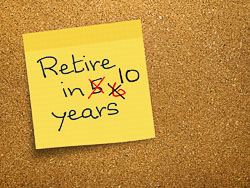According to the U.S. Bureau of Labor Statistics, approximately 250,000 serious injuries occur each year to hands, fingers, and wrists. About 8,000 of these result in amputations. A worker’s hands are so incredibly critical not only to their career, but also their personal lives. Action can be taken to help minimize the hazards to hands, especially through the use of equipment safety mechanisms, personal protective equipment (PPE), and proper training.
3 min read
Getting A Grip On Hand Protection
By Gibson on Sep 24, 2014 6:30:00 AM
Topics: Commercial Insurance Risk Management Construction Claims Health Risk Management Workers' Compensation
4 min read
Safety Culture: Setting Your Sights At Zero
By Art Jacobs on Sep 19, 2014 6:30:00 AM
What Is The Mark Of A Proactive Safety Culture?
Early in my career I spent time working in manufacturing as a safety director. After an injury occurred, we would complete the accident investigation and root cause analysis. We figured out what happened, when it happened, why it happened, and how it happened. From there we determined how to keep the injury from occurring again. But why weren’t we doing this before the injury? Why weren’t we doing inspections, reviews, and managing processes BEFORE an injury to prevent it? Why were we waiting until an injury occurred?
Topics: Commercial Insurance Risk Management Executive Construction Claims Health Risk Management Workers' Compensation
2 min read
Helping Employees Make Good Health Care Decisions
By Gibson on Sep 15, 2014 6:30:00 AM
Health care costs are higher than ever before and they aren’t going to get any cheaper. According to a study by the Centers for Medicare and Medicaid Services, health care spending in the United States is expected to total $4.8 trillion by 2021. Wow. How are we, the “consumers”, going to slow down this ship? There is no one answer to this question, but there are several ways employers can help play a role.
Topics: Employee Benefits Health Care Reform Health Risk Management
2 min read
Stressed Out?!?!
By Nicole Fallowfield on Sep 10, 2014 6:30:00 AM
In all of the years I’ve spent working in the wellness industry the one topic that comes up more frequently than any other is stress. In particular, how employers can help their employees better manage their stress. And I have to admit, while it comes up a lot this is a tough one to address for a couple of reasons—1. most issues affecting stress levels are complex, and 2. how we deal with stress is intensely personal.
Topics: Employee Benefits Health Risk Management Personal Insurance & Risk Management
3 min read
Strategies For Protecting Your Workers From Hazardous Noise
By Gibson on Aug 27, 2014 6:30:00 AM
According to the National Institute for Occupational Safety and Health (NIOSH), about 30 million workers in the U.S. are exposed to hazardous noise. One of the most common occupational diseases is noise-induced hearing loss. With this many workers at risk each day, it also means very high risks of workers’ comp claims, which can be very costly to companies. What can be done? How can you protect your workers against hearing loss?
Topics: Commercial Insurance Risk Management Construction Claims Health Risk Management Workers' Compensation
2 min read
Health Care Pricing And The Value Of Transparency
By Gibson on Aug 20, 2014 6:30:00 AM
What was the price of a gallon of gas this morning on the way to work? You could probably easily rattle off the answer. Big neon signs outside convenience stores on numerous street corners make this request pretty simple. But do you know what your monthly prescription costs are? Or the total price of a simple visit to your family doctor?
Unfortunately a majority of Americans would probably struggle to answer these questions. Most people would say it’s the amount of their health insurance. But this is only part of the overall cost. In a third party payer system, shadowed by copays and very opaque pricing, most people honestly don’t realize the true cost of their health care.
Topics: Employee Benefits Health Care Reform Health Risk Management
2 min read
Optimism Reigns!
By Nicole Fallowfield on Aug 11, 2014 6:30:00 AM
One of our seven core values at Gibson is Optimism Reigns: Attitude and outlook impact results. While I appreciate and think all of our values are important, this one can make or break an organization. Unfortunately, I have personally witnessed the meltdown of teams, work ethic, and overall productivity in past jobs. Optimism and attitude were nowhere to be found. And the health of the organization suffered. Our CEO, Tim Leman, previously shared his take on this core value in his Rejoice! Thorns Have Roses! blog.
Topics: Health Risk Management
3 min read
The Critical Role CDHPs Play In Controlling Health Care Costs
By Gibson on Jul 21, 2014 6:30:00 AM
Think of the last time you paid a visit to your doctor. What type of care or treatment did you receive? Did you know the cost? Chances are, you didn’t. You probably knew the amount of your deductible, coinsurance, or copayment, but who cares about the total bill, right? After all, your health insurance covered the rest. But therein lies the problem. Not only do we lack that information, but also the motivation to seek that information with the current third-party payer system.
Topics: Employee Benefits Health Care Reform Health Risk Management
1 min read
Make Health A Priority
By Nicole Fallowfield on Jul 7, 2014 6:30:00 AM
Last month, I talked about Gibson’s mission “To Protect What Matters Most” and submitted that health, and more importantly vitality, is what matters most. A couple of weeks ago I had the opportunity to hear the acting U.S. Surgeon General, Rear Admiral Boris D. Lushniak, M.D., M.P.H., speak at the headquarters for the American College of Sports Medicine in Indianapolis. At one point during his talk, Dr. Lushniak said “People get elected or not elected based on the economy…but I’ll submit to you today, that economy is doing nothing unless we have healthy people who are able to be part of that economy. So where does health lie on the priority of things?” Good observation. Even better question.
Topics: Risk Management Employee Benefits Health Risk Management Personal Insurance & Risk Management
2 min read
Strategies For Managing The Health & Safety Of An Aging Workforce
By Gibson on Jun 23, 2014 10:13:00 AM
As baby boomers reach retirement age, many are choosing to work longer, thus changing the demographic makeup of your workforce. There are proven benefits – they are some of your most loyal and experienced employees, which makes it important for risk and safety professionals to look for targeted strategies to safeguard the safety of their aging workforce.
Studies show that one in four workers will be older than age 55 by 2030. According to the U.S. Census Bureau, the numbers of workers age 55 and over will increase from 19 million in 2020 to 32 million by 2015. Workers have several motivators for working longer including improved medical treatment, financial needs (short-term and for retirement), the opportunity to use their talents and skills, to keep mentally and physically healthy, and the enjoyment of work. Regardless of the motivating factor, it is clear that the aging workforce trend is going to be bringing changes to the workforce in the years to come.










.jpg)